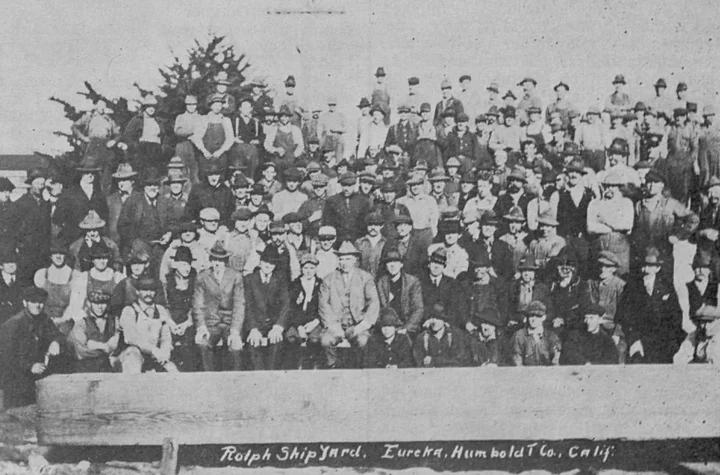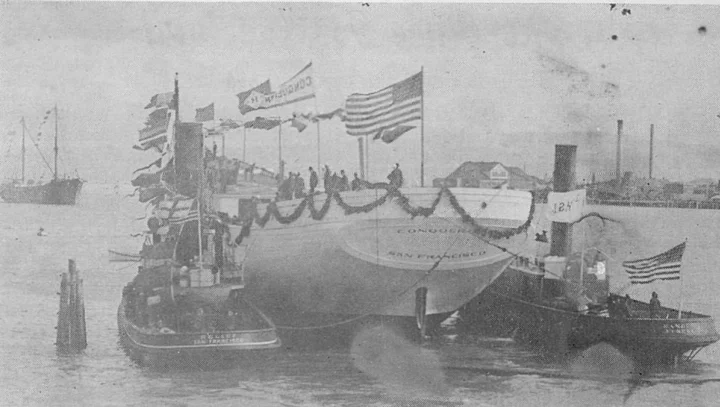Mayor James Rolph (front row, center) pictured with the men who built his ships. Upwards of 250 men were employed at the Rolph Shipyards during World War I. Photos via Humboldt Historian.
NOTE: This article is reprinted from the January 16, 1918 issue of the San Francisco Chronicle.
###
It was only a few days after the United States declared war against Germany that James Rolph, Jr., Mayor of San Francisco, entered the ranks of shipbuilders. He had long forseen what was going to happen to the shipping trade, and in other ways he had been preparing for it, in his capacity as head of the Rolph Navigation and Coal Company.
Seeing an opportunity to purchase the old Bendixsen shipyards, located at Fairhaven, across Humboldt Bay from the city of Eureka, he did so. And since then perhaps no individual has done more than he to increase America’s merchant marine by building vessels to replace those sunk by the enemy.
The plant now known as the Rolph Shipbuilding Company’s yards was established in 1868 by the late H. D. Bendixsen, one of the pioneer shipbuilders of the Pacific Coast. During his career up to the time of its being taken over by the Rolph Shipbuilding Company, it turned out and launched 208 craft of all kinds and sizes, both sail and steam.
A generation ago shipbuilding on Humboldt Bay was virtually all Bendixsen. Today it is virtually all Rolph, for Rolph dominates the field not alone in the size of the yards and their productiveness, but also in the number of employees, the up-to-dateness of the plant, and the fair and persistent manner with which he goes about to do things and do them right.
The original Bendixsen property, purchased by the Rolph Shipbuilding Company, has a water frontage of 850 feet. It was under lease at the time of the sale to another concern, which occupied it with a couple of half-completed ships.
Instead of sitting down and waiting until the lease should expire, Rolph, who was anxious to do his bit toward combating the submarine menace, negotiated for and purchased a frontage of 950 feet, the old Fay property, adjoining the Bendixsen place on the north.
A little later he bought another 250 feet directly south of the Bendixsen plant, giving him a water frontage of 2050 feet in all, with a depth of about 500 feet to the property.
In April the Bendixsen yards were purchased. On June 10 following, the keel of the first vessel was laid on the adjoining property and construction work began with a rush.
Four vessels were entirely in frame by October. On December 7, 1917, the lease on the Bendixsen property expired and the plant was taken over, the keels of three more vessels being laid there immediately, making seven in all on the ways.
When it came into being, the Rolph Shipbuilding Company fixed as one of its foundation policies the fair treatment of its employees. The men were allowed to unionize and were paid highest union wages.
The working day was cut to eight hours and each Saturday was made pay day. Moreover, the employees were given to understand that the company was their friend. They were told that, for instance, no charge would be made for hospital service, and that in every other way they were to be made to like their jobs. Just in passing it might be mentioned also that Rolph a few weeks ago made a standing offer of a $100 bank account for every baby born at Fairhaven.
The unionization of a plant that for decades had been nonunion made friends for the Rolph Shipbuilding Company in all but one or two quarters. Those who did not feel as Rolph felt about labor and its rights happened to control the lumber situation. But this availed themselves nothing, for barges were sent by the company to the Columbia River and Puget Sound and the necessary fir timber brought from there — and the Rolph yards continued thrive.
With flags flying and a number of guests aboard, the barkentine Conqueror was launched from the Rolph Shipyards on February 22, 1918. The tugs Relief (left) and Ranger have picked her up and are about to tow her back to the outfitting dock.
Of the four vessels first started, three are 2500-ton general cargo vessels (steamers). They are 250 feet long between perpendiculars, with a beam of 45 feet 6 inches, and a depth of hold of 19 feet 6 inches.
They are being equipped with 1000-horsepower reciprocating engines and Heine water-tube boilers built and installed by the Union Iron Works of San Francisco.
The fourth vessel is a barkentine, four-masted, of about the same dimensions. It will carry 1,650,000 feet of lumber, or some 2200 tons dead weight.
The three vessels, whose keels were but recently laid, will all be barkentines. Not one of the craft but is being built to the highest classification of the American Bureau of Shipping, the American Lloyds. For instance, other shipyards leave as much as ten inches between the frames of their wooden vessels. In the vessels built at the Rolph yards, six inches is being left between ribs, so that all the ships will be given the maximum of sturdiness, though at a greater cost to build.
The first vessel to be launched will be a barkentine, which will take to the water on Washington’s birthday, February 22. Then one steamer will be launched each month until the three under construction are in the water As soon as one craft is afloat another keel will at once be laid on the vacant ways.
Besides the new construction going on at the yards, old craft are being overhauled and remodeled and made fit for sea again. The once famous clipper ship May, which for the past few years has been used by the Rolph Navigation and Coal Company as a barge, was recently repaired and fitted out as a three-masted barkentine.
###
The reprint above appeared in the January-February 1977 issue of the Humboldt Historian, a journal of the Humboldt County Historical Society. It is reprinted here with permission. The Humboldt County Historical Society is a nonprofit organization devoted to archiving, preserving and sharing Humboldt County’s rich history. You can become a member and receive a year’s worth of new issues of The Humboldt Historian at this link.


CLICK TO MANAGE